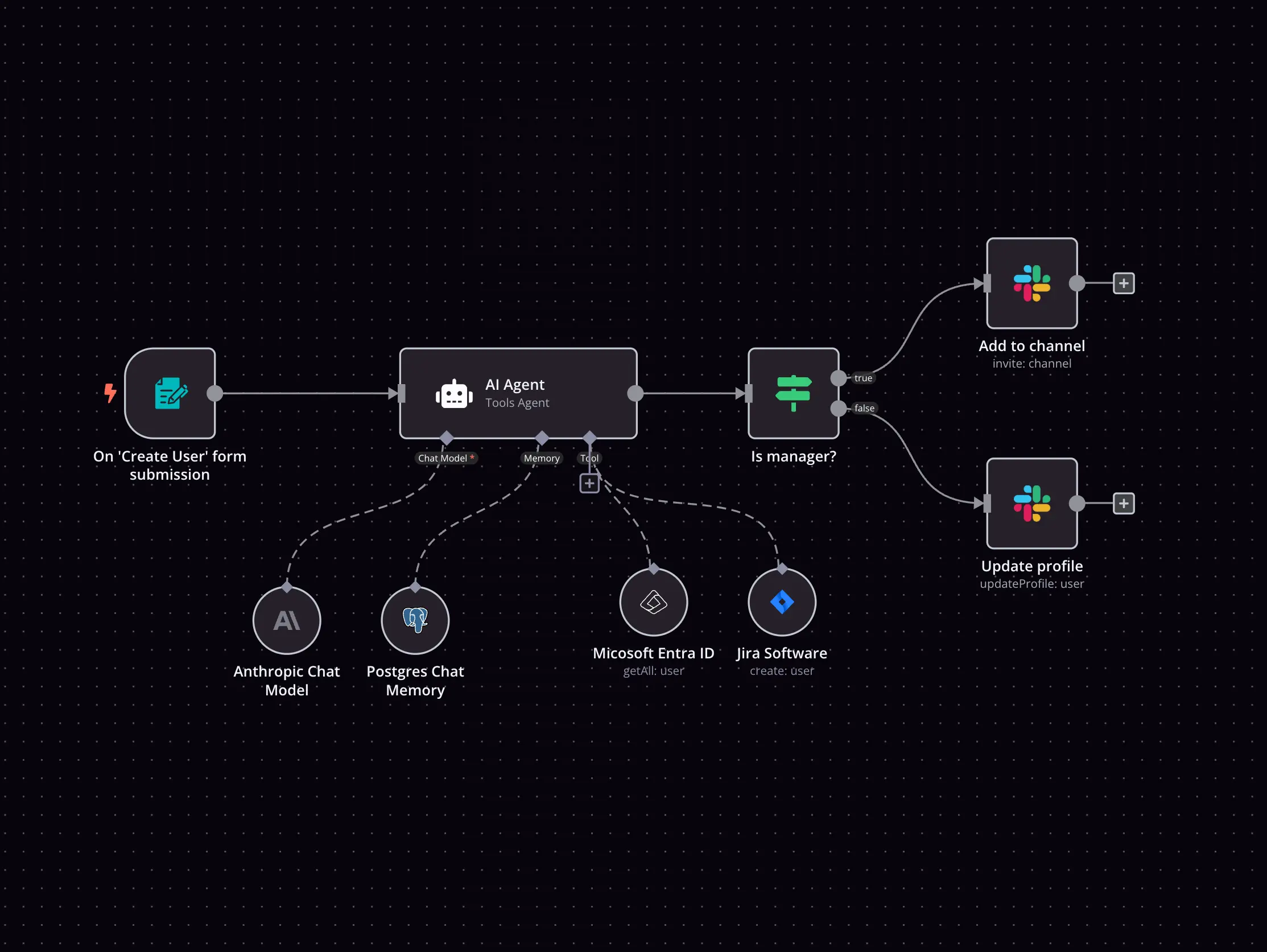Flotiq and Landbot integration
Save yourself the work of writing custom integrations for Flotiq and Landbot and use n8n instead. Build adaptable and scalable Development, workflows that work with your technology stack. All within a building experience you will love.


How to connect Flotiq and Landbot
Create a new workflow and add the first step
In n8n, click the "Add workflow" button in the Workflows tab to create a new workflow. Add the starting point – a trigger on when your workflow should run: an app event, a schedule, a webhook call, another workflow, an AI chat, or a manual trigger. Sometimes, the HTTP Request node might already serve as your starting point.
Build your own Flotiq and Landbot integration
Create custom Flotiq and Landbot workflows by choosing triggers and actions. Nodes come with global operations and settings, as well as app-specific parameters that can be configured. You can also use the HTTP Request node to query data from any app or service with a REST API.
Supported API Endpoints for Flotiq
List content types
Retrieves a list of all content types available.
Create content type
Creates a new content type.
Update content type
Updates an existing content type.
Get single content type
Retrieves details of a specific content type.
Delete content type
Deletes a specific content type.
Create content type
Create a new content type definition.
Get content type
Retrieve a specific content type definition.
Update content type
Update an existing content type definition.
Delete content type
Delete an existing content type definition.
Create content type
Creates a new content type for the application.
Update content type
Updates an existing content type in the application.
List content types
Retrieves a list of all content types available in the application.
Get single content type
Retrieves a specific content type by its ID.
Delete content type
Deletes a specified content type from the application.
Create content type
Creates a new content type definition via API.
Update content type
Updates an existing content type definition.
List content types
Retrieves a list of content type definitions.
Get single content type
Retrieves a single content type definition by ID.
Delete content type
Deletes a specific content type definition by ID.
List content objects
Retrieves a list of all content objects.
Create content object
Creates a new content object.
Update content object
Updates an existing content object.
Get single content object
Retrieves details of a specific content object.
Delete content objects
Deletes a specific content object.
Create content object
Creates a new content object in the application.
Update content object
Updates an existing content object in the application.
List content objects
Retrieves a list of all content objects available in the application.
Get single content object
Retrieves a specific content object by its ID.
Delete content object
Deletes a specified content object from the application.
List deleted content objects
Retrieves a list of all deleted content objects.
Create content object
Creates a new content object based on a content type.
Update content object
Updates an existing content object.
List content objects
Retrieves a list of content objects.
Get single content object
Retrieves a single content object by ID.
Delete content object
Deletes a specific content object by ID.
Retrieve content object
Retrieve the schema of a specific Content Object by sending a GET request.
Delete content object
Delete a specific Content Object identified by its ID.
Retrieve GraphQL schema
Retrieve the GraphQL schema that describes your data.
Execute GraphQL queries
Execute GraphQL queries to retrieve specific data.
Get blogposts
Retrieve details of blogposts content type.
Create content type
Create a new Content Type Definition in the system.
Update content type
Updates the definition of the specified content type using a PUT request.
Update blogposts
Updates the schema definition for blog posts.
To set up Flotiq integration, add the HTTP Request node to your workflow canvas and authenticate it using a generic authentication method. The HTTP Request node makes custom API calls to Flotiq to query the data you need using the API endpoint URLs you provide.
See the example hereThese API endpoints were generated using n8n
n8n AI workflow transforms web scraping into an intelligent, AI-powered knowledge extraction system that uses vector embeddings to semantically analyze, chunk, store, and retrieve the most relevant API documentation from web pages. Remember to check the Flotiq official documentation to get a full list of all API endpoints and verify the scraped ones!
Supported API Endpoints for Landbot
Get channel data
Returns channel data of a specified channel ID.
List channels
Returns your channels data.
Create hook
Creates a message hook for the specified channel
Delete hook
Deletes a specific message hook from a channel
List WhatsApp templates
Returns your WhatsApp templates data.
List whatsapp templates
Returns whatsapp templates to send with more than one channel.
Opt out customer
Delete opt-ins of a specific customer.
Send template
Sends template message to a specific customer.
Delete customer
Deletes a specified customer by ID.
Get customer data
Returns data of a specified customer ID.
List customers
Returns a list of all customers.
Send WhatsApp template
Sends a WhatsApp template to a specified customer.
Send image
Sends an image to a specified customer.
Send location
Sends a location to a specified customer.
Send text
Sends a text message to a specified customer.
Archive customer
Archives a specified customer by ID.
Unarchive customer
Unarchives a specified customer by ID.
Archive customer
Archives a specific customer.
Assign bot to customer
Assigns a specific customer to a specific bot.
Assign customer to agent
Assigns :customer_id to :agent_id
Assign customer to self
Assigns :customer_id to you
Block customer
Blocks :customer_id
Delete customer
Delete customer :customer_id
Send image
Sends an image message to a specific customer by customer_id.
Send location
Sends a location message to a specific customer by customer_id.
Send text message
Sends a text message to a specified customer.
Unarchive customer
Unarchives a specified customer.
Unassign customer
Unassigns a specified customer.
Unblock customer
Unblocks a specified customer.
Delete field
Deletes field :field_name from customer with id :customer_id
Create customer
Create a new customer entry.
Read customer
Read specific customer details by token.
Update customer
Update details for an existing customer by token.
Read customer
Read customer information based on customer token.
Update customer
Update customer details based on customer token.
Create customer field
Creates a new customer field.
Delete customer field
Deletes a specified customer field.
Create message hook
Creates a new message hook for a specific channel.
Change field value
Changes the value of a specified field for a customer.
Get data
Get data of a specific agent by ID.
Send message
Send a message to a customer with a given token.
Send messages
Send messages to the specified webhook URL.
To set up Landbot integration, add the HTTP Request node to your workflow canvas and authenticate it using a generic authentication method. The HTTP Request node makes custom API calls to Landbot to query the data you need using the API endpoint URLs you provide.
See the example hereThese API endpoints were generated using n8n
n8n AI workflow transforms web scraping into an intelligent, AI-powered knowledge extraction system that uses vector embeddings to semantically analyze, chunk, store, and retrieve the most relevant API documentation from web pages. Remember to check the Landbot official documentation to get a full list of all API endpoints and verify the scraped ones!
Flotiq and Landbot integration details
FAQ
Can Flotiq connect with Landbot?
Can I use Flotiq’s API with n8n?
Can I use Landbot’s API with n8n?
Is n8n secure for integrating Flotiq and Landbot?
How to get started with Flotiq and Landbot integration in n8n.io?
Looking to integrate Flotiq and Landbot in your company?
The world's most popular workflow automation platform for technical teams including
Why use n8n to integrate Flotiq with Landbot
Build complex workflows, really fast


